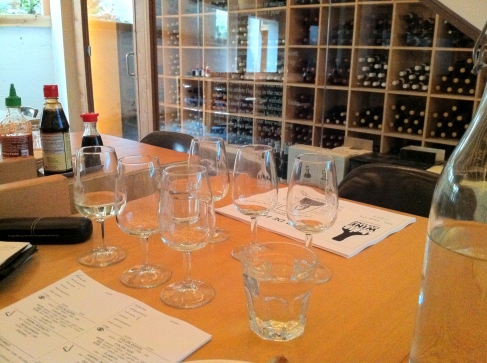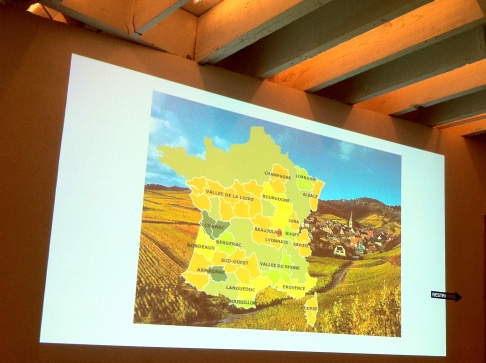Tobacco, grapefruit, black pepper, and leather– these are some of the exalted, ethereal flavors one can find in wine. Disappointment can sometimes be found there, too. But not at the “Tour de France Wine Tasting” we attended in Silverlake on August 24.
The only disappointment for us was that we had not been able to taste wine in Chateauneuf-du-Pape as we had hoped. Earlier this summer, Alberto and I were going to spend three weeks in Spain and Provence. We had planned to view the 100th Tour de France in Vaison la Romaine and drink wine nearby in the famed village of Chateauneuf-du-Pape.
Due to a last-minute professional commitment at home, however, we had to cancel our trip. We were both heartbroken. So when I received an email from Los Angeles Wine Tasting (http://lawinetasting.com/) about a “Tour de France” wine tasting, we couldn’t resist and signed up for it immediately. It definitely did not disappoint.
We gathered in the underground wine cellar of Blossom, a Vietnamese restaurant in the Silverlake neighborhood, a trendy area with a Bohemian air near downtown. Sommelier Jean-Baptiste Dhalluin guided us through a flight of six wines (three white and three red) from some of the key wine-producing regions of France: Champagne, Bordeaux, Burgundy, Loire and Rhone Valleys, Alsace and Provence.
Although I’m not passionate about white wines, I must say that the three we tasted were exquisite. I rarely ever say that about white wine.
The first was a dry, clean and crisp Sauvignon Blanc (2011 vintage) produced in the Sancerre area of the Loire Valley by Patient Cottat. The aromas of green apple and vanilla yielded to the flavors of grapefruit and grass, with notes of minerality. This refreshing wine would pair well with oysters, white fish or goat cheese.
Next, we were presented with Champagne, not the usual sparkling wine that passes for Champagne, but Champagne Grand Cru, Mesnil-sur-Oger produced in the Champagne region by Andre Robert from 100% Chardonnay grapes. The grapes are grown in a secondary foundation of limestone. The result is a smooth, dry minerality, balanced with notes of brioche, pear and apple. It’s delicious by itself or with seafood or cheese.
Andre Robert’s grandson Bertrand, who took over the Robert estate in 1981, continues his grandfather’s commitment to the practice of “viticulture durable” (sustainable viticulture) in which there are no insecticides or preservatives used. The Champagne Grand Cru, Mesnil-sur-Oger is considered an estate-grown wine (or “Grower Champagne”) because all of the fruit in this sparkling wine is grown on the estate and it is made at that estate. A Grower Champagne can be identified by the initials RM (Récoltant-Manipulant) on the wine label. The initials are very small, so you have to search for them.
Our third white wine was a unique surprise, a vintage 2011 made from two varietals with which I’m not familiar: Roussanne (80%) and Marsanne (20%). Crozes Hermitage, produced in the Rhone Valley by Laurent Habrard, is viscous, soft and silky on the mouth, with aromas of vanilla, honey and a hint of butter. Subtle citrus flavors underscore a creamy, nutty character with smooth acidity for a nice balance.
A sublime 2011 Pinot Noir produced by Contat-Grange and grown organically in the heart of Burgundy, Maranges, was the first of the reds that we tasted. This silky ruby beauty showed some age and gave off the aromas of dry rose, earth, cherry and cigar butt balanced perfectly with soft tannins and the flavors of ripe cherries, earth and a hint of spice. Boeuf Bourguignon would be the perfect dinner paring.
The second red was a deep purplish, aromatic Cotes du Rhone from producer Eric Bonnet in the Southern Rhone Valley. Made from Grenache (80%) and Syrah (20%), this vintage 2012 blend was already showing some age with its medium tannins. This flavorful wine is balanced beautifully with fresh acidity, mineral, earthy, leather flavors and aromas of raspberry and black cherry. A delight!
The highlight of the afternoon was an aged, deep garnet wine from one of my favorite wine regions, Bordeaux. This 2009 vintage was a blend of Merlot and Cabernet-Sauvignon produced by Cap Leon Veyrin in Bordeaux, Listrac-Medoc Appellation on the left bank of the Garonne River. Jean-Baptiste explained that wines from the left bank tend to be more masculine than wines from the right bank. Its aromatic intensity infuses black cherry, mineral and spice in the nose and the taste was full-bodied and flavorful with mineral, fresh acidity and dry tannins.
When Alberto and I finally do escape to France, perhaps we should pay a visit to one or more of these estates. For next year, I’m eyeing a horseback riding wine tour in Bordeaux. We’ll keep you posted.




